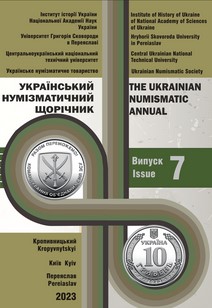МОНЕТНІ ЛЕГЕНДИ ЯК ДЗЕРКАЛО ОЛЬВІЙСЬКОЇ ПАЛЕОГРАФІЇ
THE COIN LEGENDS AS A MIRROR OF OLBIAN PALEOGRAPHY
Author(s): Mykola NikolaevSubject(s): Archaeology, Economic history, Local History / Microhistory, Ancient World, Source Material
Published by: ДВНЗ Переяслав-Хмельницький державний педагогічний університет імені Григорія Сковороди
Keywords: Olbia; coins; legends; letters; numismatic paleography; lapidary paleography; manuscript paleography;
Summary/Abstract: The purpose of the article is a preliminary (selective) analysis of certain manifestations of paleographic features in the legends of Olbian coins in comparison with the lapidary and manuscript paleography of classical and hellenistic Olbia. The present article is a direct continuation of theoretical studies of legends (letters, abbreviations, and monograms) on coins of classical & hellenistic time of Olbia. The theoretical and methodological background of the study is typical scientific methods, including system analysis, combined with the author's own research. In this case, we used a recently proposed tool for the synthesis of numismatic classifications and prosopography interpretations of legends on the chronological basis of the restored of Olbian eponym chronology. Scientific novelty. For the first time in the last half-century, selective studies of numismatic paleography in comparison with lapidary and manuscript paleography of classical and hellenistic Olbia have been carried out using new chronological tools. Main results of the research. For several years, we have been conducting theoretical studies of the legends of Olbian coins of the classical and hellenistic periods. In particular, we have obtained materials to prove that the abbreviations of names (monograms, differents) on these coins are not eponymous. A new research tool – a synchronised eponym catalogue – has made it possible to identify dozens of abbreviations (monograms, differents) with real historical figures – eponyms of Olbia – who, according to ancient tradition, held the position of coin magistrate chronologically close to the execution of the position of eponym. Accordingly, a large group of coins received relatively accurate prosopographic dating, unlike traditional onomastic interpretations of coin abbreviations that do not provide a real historical context. Further prosopographic studies of coin legends, combined with numismatic classifications (groups, subgroups, types) on the chronological basis of the eponym catalogue, allowed us to develop an objective chronological scheme of the first series of minted copper and the ―obol series”, coins with the legend ΒΣΕ, etc. Prosopographic studies of the differents on the ―borysphens” made it possible to revise the established chronology of these coins and propose a scheme that is an improvement of the chronological scheme of P. O. Karyshkovsky and others. At the same time, further progress in the proposed direction raises the question of ensuring the system nature of research, in particular, in addition to prosopographical (chronological) studies, the coins of Olbia of the classical and hellenistic periods can be studied with the help of paleography. The restoration of the Olbian chronology – the synchronisation of the IPE I2 201 eponym catalogue – has in recent years made it possible to obtain virtual chronological series of both lapidary monuments and monuments of manuscript epigraphy (graffiti, magical inscriptions, etc.), as well coins. In particular, the prosopographic dating of all subgroups of the first series of minted copper, the ―obol series”, the ―borysphens”, the ΠΡΩ, ΒΣΕ series, etc. was published. Accordingly, the obtained chronological information makes it possible to carry out comparative studies in lapidary, manuscript and numismatic paleography at a new level for the first time in the last half century, which is the task of the future. However, we understand that such a study, in particular, will involve the analysis of a huge amount of information, so the purpose of the proposed article is limited to preliminary remarks and a selective analysis of some striking manifestations of paleographic features of the legends of Olbian coins in comparison with lapidary and manuscript paleography. In general, the analysis was based on somewhat simplified paleographic forms of letters, without any specific nuances. As a result of the study, the following was obtained:1. A selective comparative analysis of the numismatic, lapidary and manuscript paleography of сlassical and hellenistic Olbia generally confirms the necessity to revise the established notion of parallelism in the development of these areas; some nuances have been revealed 2. For example, some letters, such as alpha with broken transverse line, were used in numismatics very sporadically; theta with the horizontal line was not used in numismatic paleography at all 3. The italic font, widely used in the lapidary and manuscript paleography of Olbia from the beginning of the II century BC, in particular, the italic epsilon and omega, are not presented in numismatic paleography. 4. Another feature of numismatic paleography is the sometimes asynchronous completion (compared to the lapidary archive) of the use of individual letters. 5. There is an unsuccessful attempt to apply to numismatic paleography the one- and two-point interpunction (in fact, the errors of casting (sic)) used in lapidary and manuscript paleography of the predominantly classical period. 6. Numismatic paleography is characterized by the presence of retrograde legends, unlike lapidary paleography. Retrograde legends arise as a result of incompetence of craftsmen. 7. Note that in the proposed article we do not raise the issue of numismatic paleographic dating. 8. We also obtained other results. The perspective of further research. The hypotheses formed in view of the complexity of the real processes in the coinage of Olbia should be considered as preliminary. In general, the conducted selective comparative studies of Olbian paleography require further development on a system basis.
Journal: Український Нумізматичний Щорічник
- Issue Year: 2023
- Issue No: 7
- Page Range: 25-39
- Page Count: 15
- Language: Ukrainian

